You hear it said that by some that comic book continuity is a barrier to new readers...that the long, complicated back story on some titles is too impenetrable to the newbie, and drives them away.
How true is this?
Obviously, continuity can get ridiculously over complex. In any given X-Title, you might encounter 3 or 4 different heroes from different alternate futures, or alternate pasts, or heavens knows what. Ye gods, thanks for the migraines, Chris Claremont.
However, other forms of serial fiction have multi-decade back stories that, alternate futures aside, makes Spider-Man look like Richie Rich. Yet somehow, The Guiding Light (for example) seems to pick up viewers every year who manage to navigate the complexities of who is really whose daughter.
And even when Marvel creates a whole new line featuring old characters in brand new continuities, ostensibly to become a better gateway for new readers, eventually that continuity gets complex, too. As someone out there said (forgive, I forget who it was, let me know and full credit will be extended), once you have Ultimate Cable and Ultimate Stryfe, haven't you lost the mission for a simpler entryway?
Here's another way to look at it--were the comics of ye olden days really less complicated? Let's take one personal anecdote--me.
One of the very first non-kiddie comic books I ever owned was Marvel Triple Action #10, a 1973 reprinting of Avengers #16, from 1965. My recollection is that my grandparents purchased it for me at some flea market. It had no cover (which is just as well, because it turns out to be one of the more hideous and misleading covers ever...Sorry, Gil Kane).
This was my first exposure ever to even the concept of the Avengers, let alone an actual story. We all know this issue...it was the first big Avengers line-up shakeup, ever. Here's the original cover:
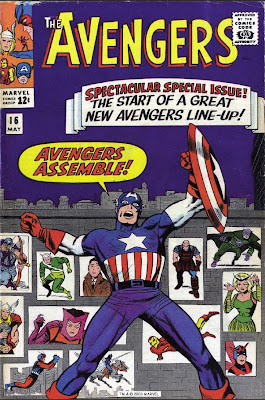 Now, just look at that...look at all those characters on that cover. Obscure villains, villains and characters from other comic books...and look at the inside:
Now, just look at that...look at all those characters on that cover. Obscure villains, villains and characters from other comic books...and look at the inside:
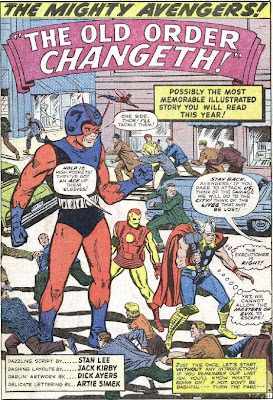 No recap, no roster page, no introduction...just a "hey, if you weren't here last issue, you'll catch up. C'mon!"
No recap, no roster page, no introduction...just a "hey, if you weren't here last issue, you'll catch up. C'mon!"
The first two pages of the comic present you with the heroes, only one of whom is identified by name, and the Masters of Evil, only one of whom is identified by name. The reader was expected to know who all these cats were. And if not, follow along and figure it out!
Meanwhile, we take a quick visit to Captain America:
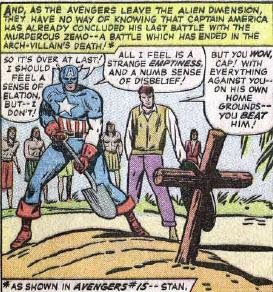 A scene entirely based on something that happened in a previous issue, which I hadn't read...with absolutely no background on Cap. or why his battle with Zemo (whoever he was) was so important, no introduction of who the heck "Rick" is...what any of the back story was. Yet somehow I kept reading.
A scene entirely based on something that happened in a previous issue, which I hadn't read...with absolutely no background on Cap. or why his battle with Zemo (whoever he was) was so important, no introduction of who the heck "Rick" is...what any of the back story was. Yet somehow I kept reading.
Then, back in NY:
 Thor leaves, off-panel (!), for some unexplained crisis. Go read his book if you want to know!! Then Hawkeye shows up out of nowhere...
Thor leaves, off-panel (!), for some unexplained crisis. Go read his book if you want to know!! Then Hawkeye shows up out of nowhere...
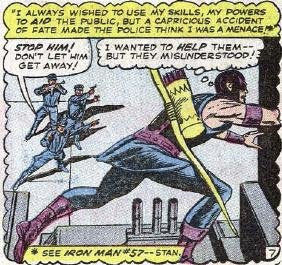 We get a decent flashback to his past appearance in Tales of Suspense...Then the Avengers go and try to recruit someone called Namor...who?
We get a decent flashback to his past appearance in Tales of Suspense...Then the Avengers go and try to recruit someone called Namor...who?
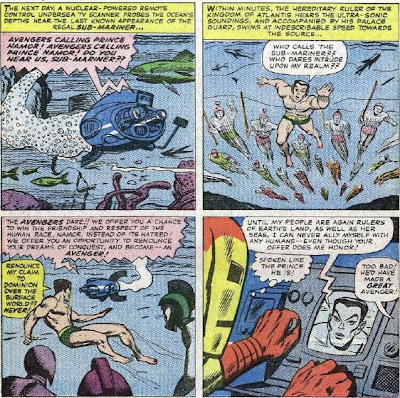 Then two weird looking people in hideous costumes show up, requiring us to know X-Men history...
Then two weird looking people in hideous costumes show up, requiring us to know X-Men history...
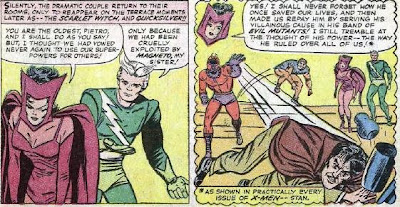 And then we see a collage of villains, most of whom are a complete mystery to a new reader:
And then we see a collage of villains, most of whom are a complete mystery to a new reader:
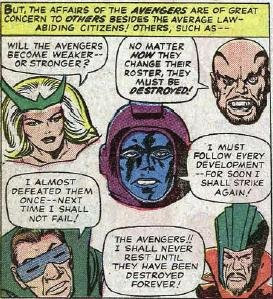 And yet...despite the fact that the issue was almost entirely based on past events I hadn't read; even though to truly appreciate everything going on you had to have a working knowledge of the Avengers' history, and the X-Men, and Iron Man, and Thor, and who those villains are---none of which I had ever encountered; even though the issue was as "hung up on continuity" as anything could be in Marvel 1965...I still enjoyed it, and wanted to read more.
And yet...despite the fact that the issue was almost entirely based on past events I hadn't read; even though to truly appreciate everything going on you had to have a working knowledge of the Avengers' history, and the X-Men, and Iron Man, and Thor, and who those villains are---none of which I had ever encountered; even though the issue was as "hung up on continuity" as anything could be in Marvel 1965...I still enjoyed it, and wanted to read more.
Did I understand everything? Hell no. But it was a good tale, entertainingly told, and Stan and Jack did a decent enough job filling me in, so as I went along I was never lost--just curious. Oh, at 10, I was no Amadeus Cho, and I didn't 100% understand everything that was referred to. But I figured out enough to enjoy the story, and the characters, and to want to know more.
Sometimes, I think, we underestimate newbies. I think people are a hell of a lot more willing to come in media res into a storyline than we give them credit for. We assume that if they don't know as much as we do, they can't possibly enjoy and appreciate what they're reading--at least not as much as we do.
And for some people, sure. But those same people would likely have been as put off by Avengers #16, from "simpler" times. As for the rest? The human mind, especially kids', are amazing things, and are capable of filling in blanks on their own, and wanting to know more about a universe. People did start watching Dallas in season 5, and somehow survived not knowing every detail of past seasons, and even became fans. People did start reading Robinson's Starman, one of the more continuity-involved series ever, and their heads didn't explode.
Sometimes, I think, we latch onto "too complicated a continuity" as a convenient excuse to explain why comics don't sell more. And it's true, some creators make their stories far, far too complex for newbies to easily jump onto. And some creators are overly obsessed with continuity navel-gazing. But somehow, those seem to be the books that sell the most, year after year.
Far more important than "too complex" is "is the story well told" and "are the characters any good" and "does this intrigue the reader enough to want to read more?" You don't need to know the history of the Golden Age and the first Crisis and Zero Hour to enjoy a JSA story, if it's done well. But sometimes, I think, we ourselves do just as much to scare newbies aways, with our "oh, the back story is too complicated for me to explain, so you wouldn't enjoy it."
As a 10-year-old I got thrown into the deep end of an Avengers story that referenced at least 20 other comic books and didn't try to hold my hand by dumbing everything down for newbies. Let's give other newbies the same benefit of the doubt, instead of assuming that they're incapable of figuring things out as they went along. I figured it out, and so can they.
How true is this?
Obviously, continuity can get ridiculously over complex. In any given X-Title, you might encounter 3 or 4 different heroes from different alternate futures, or alternate pasts, or heavens knows what. Ye gods, thanks for the migraines, Chris Claremont.
However, other forms of serial fiction have multi-decade back stories that, alternate futures aside, makes Spider-Man look like Richie Rich. Yet somehow, The Guiding Light (for example) seems to pick up viewers every year who manage to navigate the complexities of who is really whose daughter.
And even when Marvel creates a whole new line featuring old characters in brand new continuities, ostensibly to become a better gateway for new readers, eventually that continuity gets complex, too. As someone out there said (forgive, I forget who it was, let me know and full credit will be extended), once you have Ultimate Cable and Ultimate Stryfe, haven't you lost the mission for a simpler entryway?
Here's another way to look at it--were the comics of ye olden days really less complicated? Let's take one personal anecdote--me.
One of the very first non-kiddie comic books I ever owned was Marvel Triple Action #10, a 1973 reprinting of Avengers #16, from 1965. My recollection is that my grandparents purchased it for me at some flea market. It had no cover (which is just as well, because it turns out to be one of the more hideous and misleading covers ever...Sorry, Gil Kane).
This was my first exposure ever to even the concept of the Avengers, let alone an actual story. We all know this issue...it was the first big Avengers line-up shakeup, ever. Here's the original cover:
 Now, just look at that...look at all those characters on that cover. Obscure villains, villains and characters from other comic books...and look at the inside:
Now, just look at that...look at all those characters on that cover. Obscure villains, villains and characters from other comic books...and look at the inside: No recap, no roster page, no introduction...just a "hey, if you weren't here last issue, you'll catch up. C'mon!"
No recap, no roster page, no introduction...just a "hey, if you weren't here last issue, you'll catch up. C'mon!"The first two pages of the comic present you with the heroes, only one of whom is identified by name, and the Masters of Evil, only one of whom is identified by name. The reader was expected to know who all these cats were. And if not, follow along and figure it out!
Meanwhile, we take a quick visit to Captain America:
 A scene entirely based on something that happened in a previous issue, which I hadn't read...with absolutely no background on Cap. or why his battle with Zemo (whoever he was) was so important, no introduction of who the heck "Rick" is...what any of the back story was. Yet somehow I kept reading.
A scene entirely based on something that happened in a previous issue, which I hadn't read...with absolutely no background on Cap. or why his battle with Zemo (whoever he was) was so important, no introduction of who the heck "Rick" is...what any of the back story was. Yet somehow I kept reading.Then, back in NY:
 Thor leaves, off-panel (!), for some unexplained crisis. Go read his book if you want to know!! Then Hawkeye shows up out of nowhere...
Thor leaves, off-panel (!), for some unexplained crisis. Go read his book if you want to know!! Then Hawkeye shows up out of nowhere... We get a decent flashback to his past appearance in Tales of Suspense...Then the Avengers go and try to recruit someone called Namor...who?
We get a decent flashback to his past appearance in Tales of Suspense...Then the Avengers go and try to recruit someone called Namor...who? Then two weird looking people in hideous costumes show up, requiring us to know X-Men history...
Then two weird looking people in hideous costumes show up, requiring us to know X-Men history... And then we see a collage of villains, most of whom are a complete mystery to a new reader:
And then we see a collage of villains, most of whom are a complete mystery to a new reader: And yet...despite the fact that the issue was almost entirely based on past events I hadn't read; even though to truly appreciate everything going on you had to have a working knowledge of the Avengers' history, and the X-Men, and Iron Man, and Thor, and who those villains are---none of which I had ever encountered; even though the issue was as "hung up on continuity" as anything could be in Marvel 1965...I still enjoyed it, and wanted to read more.
And yet...despite the fact that the issue was almost entirely based on past events I hadn't read; even though to truly appreciate everything going on you had to have a working knowledge of the Avengers' history, and the X-Men, and Iron Man, and Thor, and who those villains are---none of which I had ever encountered; even though the issue was as "hung up on continuity" as anything could be in Marvel 1965...I still enjoyed it, and wanted to read more.Did I understand everything? Hell no. But it was a good tale, entertainingly told, and Stan and Jack did a decent enough job filling me in, so as I went along I was never lost--just curious. Oh, at 10, I was no Amadeus Cho, and I didn't 100% understand everything that was referred to. But I figured out enough to enjoy the story, and the characters, and to want to know more.
Sometimes, I think, we underestimate newbies. I think people are a hell of a lot more willing to come in media res into a storyline than we give them credit for. We assume that if they don't know as much as we do, they can't possibly enjoy and appreciate what they're reading--at least not as much as we do.
And for some people, sure. But those same people would likely have been as put off by Avengers #16, from "simpler" times. As for the rest? The human mind, especially kids', are amazing things, and are capable of filling in blanks on their own, and wanting to know more about a universe. People did start watching Dallas in season 5, and somehow survived not knowing every detail of past seasons, and even became fans. People did start reading Robinson's Starman, one of the more continuity-involved series ever, and their heads didn't explode.
Sometimes, I think, we latch onto "too complicated a continuity" as a convenient excuse to explain why comics don't sell more. And it's true, some creators make their stories far, far too complex for newbies to easily jump onto. And some creators are overly obsessed with continuity navel-gazing. But somehow, those seem to be the books that sell the most, year after year.
Far more important than "too complex" is "is the story well told" and "are the characters any good" and "does this intrigue the reader enough to want to read more?" You don't need to know the history of the Golden Age and the first Crisis and Zero Hour to enjoy a JSA story, if it's done well. But sometimes, I think, we ourselves do just as much to scare newbies aways, with our "oh, the back story is too complicated for me to explain, so you wouldn't enjoy it."
As a 10-year-old I got thrown into the deep end of an Avengers story that referenced at least 20 other comic books and didn't try to hold my hand by dumbing everything down for newbies. Let's give other newbies the same benefit of the doubt, instead of assuming that they're incapable of figuring things out as they went along. I figured it out, and so can they.

3 comments:
Actually, I happen to be one of those people. Nowadays it's easier for me to get older issues or collected stories, but back when I was a kid my first Spidey comic (I don't remember who picked it up for me) was the one where Carrior declares that he's "the living clone of Professor Miles Warren". I had no clue who that was or why I should care. And I wasn't able to find out or get further issues back in the 70's.
However, the second of what I call the "First Triumverate" is an issue of Justice League of America was one with a *subplot* about Zaranna, Elogated Man, and Red Tornado (three characters I never heard of at the time) searching for her father after events in the one-shot main story had unlocked a part of her mind.
Thanks to plot A, involving the Shark (another character I hadn't heard of) trying to create an army of mutant animals, I was able to get into the story a lot easier, because it was the beginning of each story. That was more comfortable for me, and had I funds and a comic source close enough I might have continued getting JLA, while I would have waited before picking up Spider-Man.
I also like to know at some point I could get caught up, a thought that kept me from getting long-running stories because I couldn't get the back issues. Now I can, but I still leery jumping into the deep end because the mindset has been with me a long time. So the argument isn't without merit.
Oh, and if anybody was interested, the last of the three is an issue of Batman where he was investigating homeless murders where the victim was leaving gold coins in their eyes. Being my first Batman comic, it shaped the way I view Batman, and can enjoy stories (and sometimes prefer) without the usual "rouges gallery" and just has the Batman being a detective. A good one-issue story.
That should have been "Carrion". Sorry. And I call them the First Triumverate because they were the first comic books I ever received. All were gifts, but I don't recall if I got them at the same time or which ones were first if not.
Actually, speaking as someone who only really got into the X-Men in the early 1980s (after the introduction e.g. of Rachel's future timeline and Xavier's and Magneto's dealings in the past), I never found the alternate timeline stuff off-putting per se. My main problem was that so many of these alternate-timeline guys, I'm looking at you Cable and Bishop (who btw were not created by Chris Claremont) are such lame characters.
Post a Comment